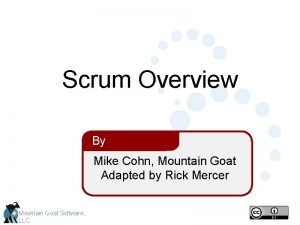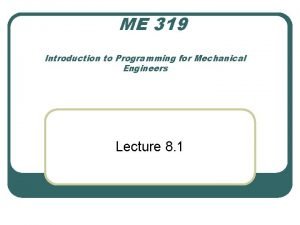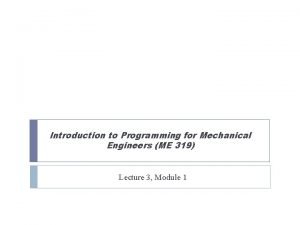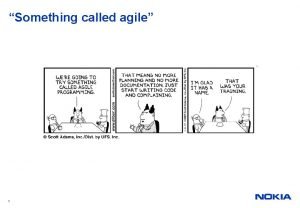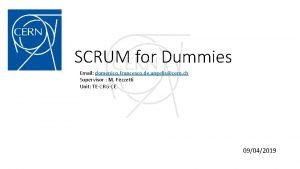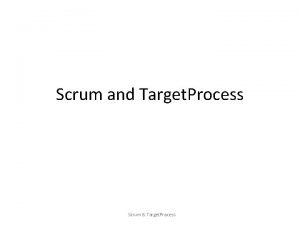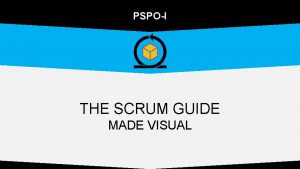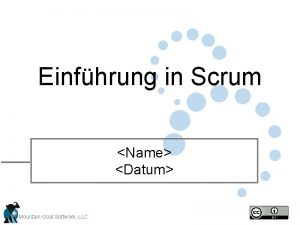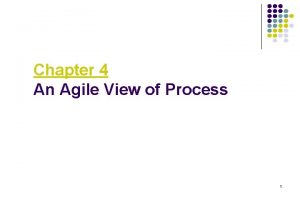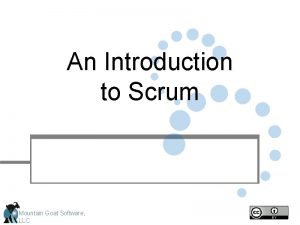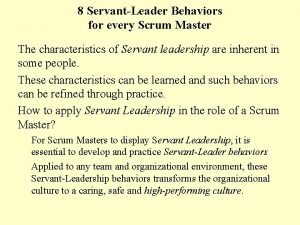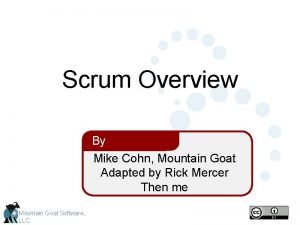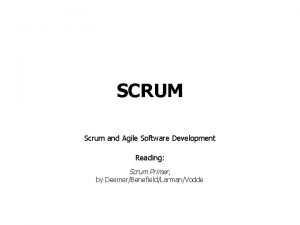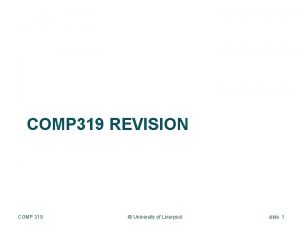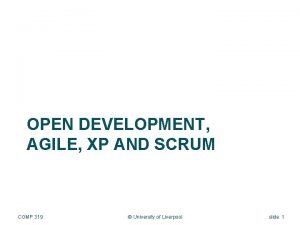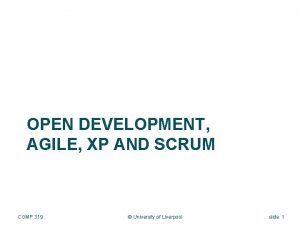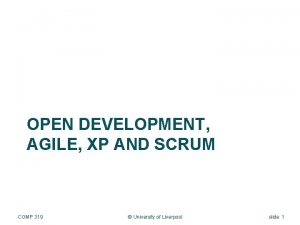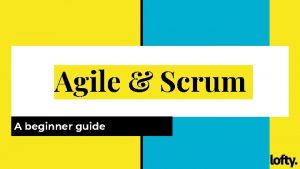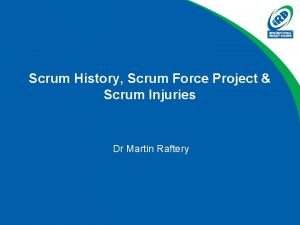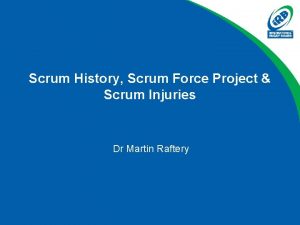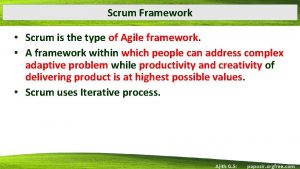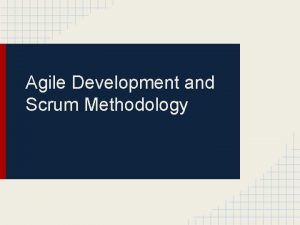AGILE XP AND SCRUM COMP 319 University of



















![XP user story example • Login - As a [registered patient] of the system XP user story example • Login - As a [registered patient] of the system](https://slidetodoc.com/presentation_image/453125af273950a2ff96a98e5df196bb/image-20.jpg)


















- Slides: 38

AGILE XP AND SCRUM COMP 319 © University of Liverpool slide 1

AGILE • Suggested in 1999/2000 by Kent Beck • Agile manifesto - 2001 • Nothing new • Agile manifesto - Individuals and interactions over processes and tools - Working software over comprehensive documentation - Customer collaboration over contract negotiation - Responding to change over following a plan COMP 319 © University of Liverpool slide 2

Agile 12 principles (1 -6) • Customer satisfaction by rapid delivery of useful software • Welcome changing requirements, even late in development • Working software is delivered frequently (weeks rather than months) • Working software is the principal measure of progress • Sustainable development, able to maintain a constant pace COMP 319 © University of Liverpool slide 3

Agile 12 principles (7 -12) • Face-to-face conversation is the best form of communication (co-location) • Projects are built around motivated individuals, who should be trusted • Continuous attention to technical excellence and good design • Simplicity • Self-organizing teams • Regular adaptation to changing circumstances COMP 319 © University of Liverpool slide 4

Agile reading • (For: ) – Beck, K. (1999) Embracing change with extreme programming”, IEEE Computer, 32(1), 70 -78. – Beck, K. (2000) Extreme Programming Explained, Addison-Wesley. – Cockburn, A. (2001) Agile Software Development, Addison-Wesley. – Highsmith, J. A. (2000) Adaptive Software Development: A Collaborative Approch to Managing Complex Systems, Dorset House. – Palmer, S. R. & Felsing, J. M. (2002) A practical guide to feature-driven development, Prentice-Hall. • (Critical or Against: ) – Stephens, M. & Rosenberg, D. (2003) Extreme programming refactored. Apress. – Demarco, & Boehm (2003) The agile methods fray. IEEE Computer, 35(6), 90 -92. • <see also www. agilealliance. org and links> COMP 319 © University of Liverpool slide 5

Evidence for Agile approach COMP 319 © University of Liverpool slide 6

Extreme Programming (XP) • Requirements are expressed as ‘user stories’ • Programmers work in pairs • Tests are developed before code is written • All test must be successfully executed • New code is then integrated and a new system release is built • New release becomes working system COMP 319 © University of Liverpool slide 7

User stories • Short descriptions of program functionality which allows the user to “do something” • User stories are meant to be - Independent - Negotiable - Valuable - Estimable - Small - Testable COMP 319 © University of Liverpool slide 8

Small • Smaller modules are easier to estimate the timescale • Reduces the risk • Gives clear measure of progress • Keep code simpler and easier to test • Keeps code coherent • So small is beautiful COMP 319 © University of Liverpool slide 9

Independence in user stories • Each story should be implementable without reliance on other user stories • This allows each user story to be developed in parallel • Faster when more developers • This makes sure there are less development independencies • This makes sure less is less code coupling (good for quality) COMP 319 © University of Liverpool slide 10

Independence in user stories in practise • Image a user login with password reminder • Is the password reminder part of login user story • If password is part of login you now have a larger user story (not so good) • Is forgot password protocol determined by login protocol COMP 319 © University of Liverpool slide 11

Negotiable • Not all development written in original spec. always needs to be developed as is • By negotiating a stakeholder may get - Software at a cheaper price - A useful working product developed on time • Negotiation - Remove/change aspects of story to make it easier quicker to implement - Add/change functionality to make it more useful - Something may be very difficult but not very important COMP 319 © University of Liverpool slide 12

Valuable • Each user story needs to show value to the stakeholder • What if code is not connected directly to user story, for example persistence logic? - Wrap it up into other story points - All users data must be securely saved after every transaction • It is worth putting a metric on value - Value of story (1 -10) 6 - All core essential story points can get a 10 COMP 319 © University of Liverpool slide 13

Estimable • Important for scheduling • In general - Shorter user stories are easier to estimate - User stories with less unknown code are easier to estimate - User stories understood clearly by developer are easier to estimate - Big user stories can be split to make this easier COMP 319 © University of Liverpool slide 14

Testable • The login screen must look nice and be liked by most of the users - Very hard to test • The login screen must look nice and must score greater than 7/10 when we assess the screen using a random group of 20 patients - Easier COMP 319 © University of Liverpool slide 15

Testability • The username for registration must be at least 8 characters long and contain at least 1 upper and lower case letter • Test using - Junit - Test is automatic COMP 319 © University of Liverpool slide 16

Story points • Estimate of size of user story in development time • Relative estimation time - For a given team - Using a particular programming environment - Can be estimated using planning poker approach • Useful for whole project rather than 1 story COMP 319 © University of Liverpool slide 17

Story points • A user story of 10 points should take on average twice the time of one measured as 5 points but - With the same level of developer - Given the same conditions - Given no dependency issues COMP 319 © University of Liverpool slide 18

XP user story example “As a user closing the application, I want to be prompted to save anything that has changed since the last save so that I can preserve useful work and discard erroneous work. ” COMP 319 © University of Liverpool slide 19
![XP user story example Login As a registered patient of the system XP user story example • Login - As a [registered patient] of the system](https://slidetodoc.com/presentation_image/453125af273950a2ff96a98e5df196bb/image-20.jpg)
XP user story example • Login - As a [registered patient] of the system I want to be able to [login] into the system. So I can [access my records securely] Email address of patient User name Password password Response text COMP 319 Login Response e. g. Password incorrect etc. Login using Challenge Protocol 1. 432 © University of Liverpool slide 20

User stories XP criticisms • They capture only functional requirements • They are too vague for a basis of contract (perhaps only suitable for T&M project) • They are only suitable for highly experienced developers • Size estimation ignores non functional requirements COMP 319 © University of Liverpool slide 21

XP process • Planning - User stories written (customer and developers) - User stories estimated (developers) - User stories prioritized - Project plan - When will features be delivered - How often will project be iterated COMP 319 © University of Liverpool slide 22

XP planning • Order of development - Dependent core code - Smaller high priority stories - Larger high priority stories - Lower priority small stories - Lower priority larger stories • This allows you to discard less important code if time runs out COMP 319 © University of Liverpool slide 23

XP planning and testing • All high priority core code needs testing properly before - Development of low priority code • If higher priority is developed but not totally tested and debugged - It is INCOMPLETE! • Only code that has completed testing is complete code COMP 319 © University of Liverpool slide 24

XP Development phase • Software is released on a regular schedule (weekly, fortnightly) • Unit tests • Developed by development team • Acceptance tests • Specified by customer • Can be script (user input, acceptable output) • Ideally also automated COMP 319 © University of Liverpool slide 25

Problems with Agile • • Contract issues and costs Code quality and design Managing large projects Does it work? COMP 319 © University of Liverpool slide 26

XP criticisms • Feature creep • High risk (time or cost overrun) • No upfront design - Can be a big issue with database design - Can lead to design contradictions • Constant re-factoring - Increased overhead - Can break existing code • On site customer - See point 1… COMP 319 © University of Liverpool slide 27

XP criticisms • Less documentation - High communications overhead - More assumptions • Simplicity impact (object patterns) - Re-use - Flexibility COMP 319 © University of Liverpool slide 28

Pair programming • Two programmers • Driver - Writes code • Observer - Reviews code/makes comments - Ideas for code improvement • Collective code ownership - Moving code, reduces risk COMP 319 © University of Liverpool slide 29

Pair programming • Reduces chance of programmer writing poorly commented or low quality code - If the reviewer doesn’t understand the code the driver is under pressure to improve • Increases code ownership - Someone owns code if they can modify/debug test and improve it COMP 319 © University of Liverpool slide 30

The Bus Factor - Why your ‘best’ developer is your biggest problem (1) • Bus factor - 1 developer run over by bus project will halt = bus factor 1 - 2 developers run over by bus to halt project = bus factor 2 • The bus factor can be increased by - Improving code ownership http: //5 whys. com/blog/the-bus-factor-why-your-best-developer-is-your-biggest-probl. html COMP 319 © University of Liverpool slide 31

Widening code ownership • Approaches - Improve code documentation - Improve class design (more inheritance) - Reducing class size - Implementing automated testing - Use code reviewing in your development team - Move code between developers - first develops initial cut - second debugs and puts in first code changes - first does second debugging and more mod requests COMP 319 © University of Liverpool slide 32

Mentor pair programming • Lead programmer (mentor) - Solves a problem in the company’s problem domain • Trainee programmer learns - Company practises, e. g. coding standards - Company API - Issues to do with the problem domain COMP 319 © University of Liverpool slide 33

Pair programming research • University of Utah - Williams et al. 2000 - 15% increase in time to code - 15% decrease in bugs • Lui 2006 - Novices gain more than experts - Complex problems helped more than simple problems COMP 319 © University of Liverpool slide 34

William et al • 74% - “between my partner and I, we could figure everything out” • 63% - “it was the pair-pressure – I could not let my partner down” • 95% - I was more confident in our assignments because we pair programmed. COMP 319 © University of Liverpool slide 35

Williams et al One day, after I did a lot of testing on our project, I was pretty sure that the project was high quality. I then gave it to my partner. I did not expect he would find any errors. Guess what? He found an error in just two minutes! Oh dear, why didn’t I notice that? We all know, two heads are better than one. Pair-programming enabled our project to have higher defect prevention and defect removal. As a result, we got a higher quality product. COMP 319 © University of Liverpool slide 36

Pair programming criticism • Problem with matching skills - Low skill + low skill - Low skill + high skill* - High skill + high skill • No substitute for code review - Timing (are both developers available) • Personal issues - Eating habits/ bad breath! - Phone calls - Ego COMP 319 © University of Liverpool slide 37

Agile summary • Designed to reduce risk and be a realistic approach • Various parts of Agile are used in practise • Some research done to test the effectiveness of some Agile approaches (like pair programming) COMP 319 © University of Liverpool slide 38
 Agile game development
Agile game development Scrum 101
Scrum 101 Que es agile inception
Que es agile inception Dilbert product owner
Dilbert product owner Exemple de product backlog
Exemple de product backlog Mike cohn mountain goat
Mike cohn mountain goat Matthews v. eldridge
Matthews v. eldridge Art. 319 cp
Art. 319 cp Atividades administrativas
Atividades administrativas Excesso de exaçao
Excesso de exaçao Cpsc 319 u of c
Cpsc 319 u of c Cpsc 319
Cpsc 319 Cwa 319
Cwa 319 87,539,319 = 2283 + _ _ _ 3
87,539,319 = 2283 + _ _ _ 3 Hsci 319
Hsci 319 Me 319
Me 319 H 319
H 319 Me 319
Me 319 Pc 319
Pc 319 Scrum master is both a bulldozer and a shield
Scrum master is both a bulldozer and a shield Scrum from the trenches
Scrum from the trenches Cern for dummies
Cern for dummies Target process
Target process Scrum-0033
Scrum-0033 Team foundation server scrum
Team foundation server scrum Pspoi
Pspoi User story esimerkki
User story esimerkki Scrum agenda
Scrum agenda Scrum mountain goat
Scrum mountain goat Scrum points
Scrum points Dsdm
Dsdm What are impediments in scrum
What are impediments in scrum Project noise level scrum
Project noise level scrum Scrum mountain goat
Scrum mountain goat Scrum crm
Scrum crm A day in the life of a scrum master
A day in the life of a scrum master Scrum master servant leader behavior
Scrum master servant leader behavior Scrum modeli
Scrum modeli Scrum mountain goat
Scrum mountain goat





